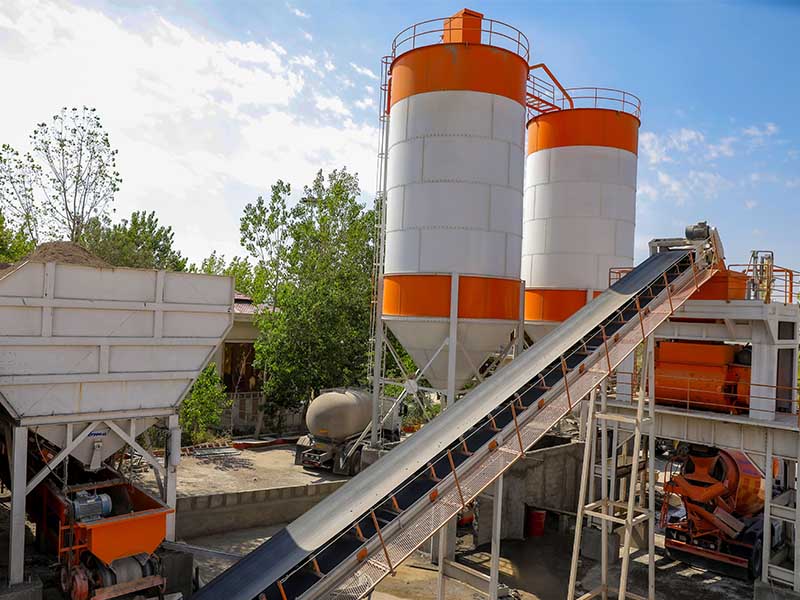What is a concrete mixing plan?
Concrete mixing is the process of combining various materials to produce the strength and durability needed for the concrete structure. Making the ideal concrete mix is a difficult task because each component of the mixture has unique properties. To ascertain the physical characteristics and bearing capacity of concrete, it is necessary to check the necessary quantity of ingredients. Stay with us to better understand the concept of concrete mixing plans and their importance in producing suitable concrete.
Purpose of concrete mixing plan
Depending on the type of project, the design of concrete mixing takes into account economic factors as well as the components of concrete for greater resistance and durability. Although the concrete mix appears to include more cement, when the mixture is designed, the proportions resulting from the design of the concrete mix are assessed for strength using compressive strength tests on concrete cubes and cylinders.
A very well mix ensures that the final structure (building, bridge, or dam) is strong. Before developing a plan for mixing concrete, the primary factors to consider are its strength, durability, and efficiency. The water-to-cement ratio and the aggregate-to-cement ratio are the primary factors that influence the properties of concrete.
The mixing plan is thus a method for determining the optimal ratios of water, cement, fine aggregate, and coarse aggregate. The objective of the mix plan is to develop the proportions of materials that will yield concrete with the desired properties. Mixing ratios should be chosen in a manner that facilitates production for the intended purpose.
Fresh concrete must be fluid enough to completely fill the mold and envelop the reinforcement. Additionally, hardened concrete must possess sufficient strength and durability. To optimize concrete’s strength, durability, efficiency, and other desirable properties, all ready-mixed concrete factories seek the optimal ratio of concrete constituents. The purpose of optimizing concrete is to maintain high concrete strength at a low cost.
Choosing the Most Effective Concrete Mixing Plan
Concrete mix design can be complicated! The selection of concrete components is determined by the requirements of the project. The design process begins with the establishment of specific requirements. In these specifications, the concrete’s exposure to weather conditions and the required resistance is considered.
To determine the compressive strength of concrete, cylindrical or rectangular standard samples are taken. Several considerations must be made, ranging from the cost of additives and different aggregates to those pertaining to shrinkage and fluidity for simple concreting.
The mixture is then designed by combining cement, coarse and fine aggregates (sand), water, and additives. The mixing method and conditions under which the concrete can be poured must also be determined.
Various types of concrete are manufactured for specialized applications. Additionally, certain computer programs can be used to design concrete mixtures. The program enables the user to select his preferred method of mixing design and input material data in order to reach the optimal mixing design.

Concrete mixing plan specifications
The low water-to-cement ratio and usage of silica fume considerably reduce the fluidity of concrete mixtures, which is essential for high-strength concrete. In order to compensate for performance loss, super lubricants are typically added to high-strength mixes.
For high-strength mixes, the aggregates must be carefully selected since aggregates with insufficient resistance to the stresses exerted on the concrete will diminish the concrete’s ultimate strength. The ideal concrete mixing strategy is one that meets all of its objectives.
The following are the three primary features of a good mixing plan:
- Compressive strength: After 28 days of curing, the strength of 95% of the poured cube must exceed the characteristic strength for which the concrete is designed.
- Concreting capability: The method in which concrete is handled and poured demonstrates its fluidity and effectiveness. The fluidity of the concrete should be considered in the design of a good concrete mix.
- High durability: Concrete needs to be strong enough to withstand the severe weather conditions for which it was made.
These are the primary features evaluated during the design of the concrete mixing plan, and concrete created under these conditions can have the most effective mixing plan. Concrete mixing design depends on its grade. The minimal grade of concrete is significant in the mixing plan when taking into account the necessary compressive strength.
Effective components in the concrete mixing plan
Several factors influence the mixing plan, including:
Compressive strength
This is one of the most crucial features of concrete when deciding on the mixing plan. The nominal water-cement ratio of the mix is determined by the average compressive strength required at a specific age, usually 28 days. The degree of compactibility is another factor that influences the strength of concrete at a given age and curing temperature.
Efficiency and fluidity
The degree of efficiency depends on three parameters, including the cross-sectional area of the concrete member, the quantity of reinforcement, and the compression technique employed. For narrow and complicated members with numerous corners or unreachable portions, concrete must have high efficiency in order to facilitate concreting and subsequent processing.
Persistence and durability
Concrete’s durability is its resistance to harsh environmental conditions. Low-strength concrete often has a limited life than high-strength concrete. When high strength is not required but there are circumstances for concreting in poor weather, good durability is critical. In this situation, the ratio of water to cement determines the desired durability.
Ratio of Aggregates
In mixing design, the aggregate ratio is crucial. The efficiency diminishes as the gravel-to-sand ratio rises because aggregates require more water to be produced. The fluidity of the concrete mixture rises with the amount of sand added. The effectiveness is also decreased by the gravel’s rough and sharp texture. To ensure that the concrete mix has high integrity and homogeneity, it is preferable to combine all sizes of gravel and sand in a proper mixing plan.
Quality Control
Changes in test results can be used to statistically measure the level of quality. Controlling the quality of concrete depends on the method of concreting, vibration, and curing. The greater the monitoring of the concrete after it has been poured, the higher the quality control. Consequently, the manufactured concrete will match the specifications outlined in the execution plans.
Other effective concrete mixing plan factors include:
Selection of cement: The selection of cement depends on the nature of the project and the weather conditions. Before incorporating cement into a mix design, the required performance of the material must be evaluated.
Type of water: Prior to use, all water used in the formulation of a concrete mixture must be tested to ensure that it falls within the acceptable range. The best type of water to use in concrete is potable water.
Water-cement ratio: The water-to-cement ratio should be evaluated for compatibility, initial and final setting, cement quality, efficiency, concrete loss, and coefficient of compaction.
Conclusion
According to the characteristics of the components, the design of the concrete mixing plan will vary considerably. The mixing strategy takes into account the existing conditions in the workplace and the varied needs of the project. All design considerations for mixing will be based on the physical characteristic data derived from testing. This vital factor ensures that the final structure is optimal and prevents the concrete member from failing due to external factors such as earthquakes. The mixing plan should be formulated by executive engineers in an engineering manner.










Leave A Comment